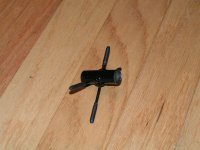jhendri2 said:Can you post a picture of your bridge? I'm not inclined myself, but I know a few guys who can build anything we design out of metal.
Jim
Here are pictures of my bridge. Basically it is made out of 1/2 inch metal conduit, with ten penny nails welded at 1 5 7 and 11 o'clock positions. The top two are cut off shorter, so I can rotate it around for shorter heights. You can actually offset all four of these positions to achieve different heights if you want. In an ideal world, I would love for the tube that the shaft slides through to be made of a plastic or nylon that would not nick up my shaft so bad, but I play with a Predator and I figure I can always get another one if it gets bad enough. Believe it or not, all it does is make a black ring down where the bridge slides all the way back when I pick up the cue. The problem with nylon or plastic though, is it may make it lighter...and on the contrary, I think it may need to be heavier.
As far as me drawing the rock, I think I am trying to punch the ball and not stroke through it. I seem to be mentally worried about hitting the cue ball more than once on my stroke. I am going to try and slow down my stroke and see what happens.
Thanks guys for all your inputs!
Shorty

